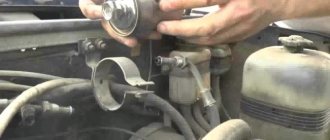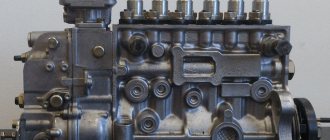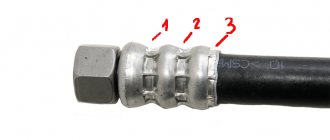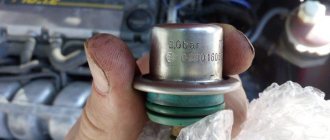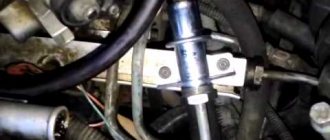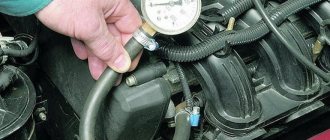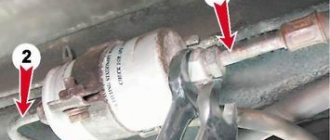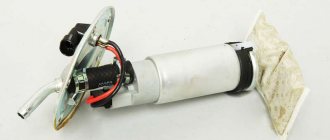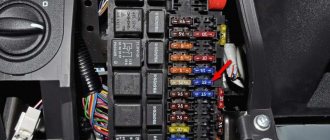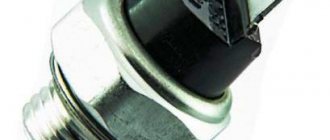The device of the VAZ 2110 gas tank
There is nothing complicated about the design of the “tens” gas tank. In fact, this is an ordinary metal fuel tank with a capacity of 43 liters. Inside this tank there is a fuel level sensor and a fuel inlet pipe with a strainer.
Diagram of the gas tank and fuel system of the VAZ 2110
An electric fuel pump is attached to this pipe externally, which pumps gasoline out of the tank and delivers it through the fuel line to the fine filter. Next, the gasoline goes to the pressure regulator and enters the fuel rail to the injectors, which spray it into the combustion chambers.
Signs of malfunction of the VAZ-2110 power system
Considering the number of power system components, it is quite difficult to unambiguously determine the cause of the malfunction. But, if you know the main “symptoms” of a breakdown, then the process of finding the cause will speed up many times. So, we list the main signs of failure of power system components:
- The car stalls (does not start). Check the operation of the fuel pump by listening to the sound from under the rear seat (with the ignition on).
- The revolutions “float”. This may be due to a malfunction of the idle air control or fuel pressure regulator in the rail.
- The engine "troits". As a rule, the cause is faulty injectors.
The fuel system of the VAZ 2110 16-valve injector has exactly the same features as the 8-valve injector.
Thanks for subscribing!
Reasons for replacing the gas tank on a VAZ 2110
There are two main reasons why a car owner will have to remove the gas tank on a VAZ 2110:
- mechanical damage to the gas tank. The tank can simply be pierced by catching it on a ledge, a stone, or some other obstacle on the road. This happens quite often. And the reason for this is the location of the tank on the “ten”. On earlier VAZ models (up to and including VAZ 2108), the gas tank was actually located in the trunk. Because of this, the trunk of these cars could not boast of spaciousness, but the gas tank was intact. Starting from the VAZ 2110, the tank is located lower, under the bottom of the car. On the one hand, the trunk capacity has increased. On the other hand, the risk of damage to the tank has increased manifold;
The tank on the VAZ 2110 is located low and is easily broken through
A completely rusted tank of a VAZ 2110
Whatever the reason, the car owner has no choice: if the tank leaks, it will have to be removed and welded (in the case when the tank is new and the damage is mechanical). If the tank is seriously damaged by chemical corrosion, then there is only one way out - replacement. Such spare parts cannot be restored.
Replacing the gas tank on a VAZ 2110
To successfully replace the tank on a VAZ 2110, we will need the following tools and materials:
- new gas tank for VAZ 2110;
- open-end wrenches - set;
- flat screwdriver.
Sequence of operations when replacing a tank
The success of the event lies in the scrupulous implementation of the following actions:
- The VAZ 2110 is installed on an overpass or on an inspection hole. The handbrake is applied.
- In the cabin, the floor covering moves back, under which there is a fuel pump hatch. The power wires are disconnected from this pump and a pair of fuel pipes are unscrewed. This is done using a 17mm open-end wrench.
Power wires and fuel pipes are removed from the VAZ 2110 fuel pump
The clamp holding the VAZ 2110 filler tube is loosened and the tube is removed
The hose on the neck of the VAZ 2110 is loosened with a socket head by 8 and then moved to the side
Two mounting bolts holding the bars on which the tank of the VAZ 2110 hangs
The slats on which the VAZ 2110 tank hangs bend down
The VAZ 2110 gas tank needs to be tilted down a little to get to the last hose
The thinnest hose is removed from the VAZ 2110 gas tank manually
The VAZ 2110 gas tank was dismantled and removed from under the car
Flushing the gas tank of a VAZ 2110
Flushing the gas tank is an operation that must be performed at least once every two years, regardless of whether the tank is in good condition or not. Over time, contaminants accumulate in the tank, which can subsequently impair the performance of both the fuel pump and other components of the fuel system.
Tank flushing sequence
To clean the gas tank, you must perform the following manipulations:
- The gas tank is removed from the VAZ 2110 as described above. After this, you need to drain all remaining gasoline from the gas tank.
- Now you need to rinse the tank. To do this, any detergent is poured into it. Even household dishwashing liquid diluted in water will do.
- After filling the liquid, the tank must be allowed to stand for at least half an hour.
- After this time, the washing liquid is drained and the tank is rinsed with clean water.
After draining the washing liquid, the VAZ 2110 tank is washed with clean water
Fuel hoses VAZ 2110-2112 high pressure (5 pcs.)
Dear customers, in order to avoid mistakes when sending a set of VAZ 2110-2112 high pressure fuel hoses, in the “Comment” line indicate your car model, year of manufacture, engine size, number of valves.
The fuel system of VAZ 2110-2112 vehicles is the most important unit, which determines the high efficiency and operability of the entire gasoline system of the unit.
The set of 2110-1104243 high-pressure fuel hoses for VAZ 2110-2112 includes:
Fuel hose Article No. 2112-1104208 – 1 pc.;
Fuel hose Article No. 2112-1104222 – 1 pc.;
Fuel hose Article No. 2112-1104226 – 1 pc.;
Fuel hose Article No. 2112-1104218 – 2 pcs.;
The fuel system of the VAZ 2110-2112 is a mechanism that is designed to supply the engine with fuel (mainly gasoline), as well as for its storage and cleaning.
The fuel system of the VAZ 2110-2112 car consists of:
— fuel gauge sensor;
The fuel is located in the fuel tank, which contains the fuel pump. When the ignition is turned on, the pump turns on and begins to supply fuel to the fuel line. The fuel passes through the fuel filter and the fuel pump, where it is cleaned by the fuel filter. Next, the fuel passes into the fuel rail. The fuel rail maintains constant pressure, which is provided by the fuel pressure regulator. Excess fuel is drained back into the fuel tank (by opening the fuel regulator, which is essentially a valve). The fuel entering the ramp is injected into the intake manifold. Fuel circulates uninterruptedly in the fuel system all the time the engine is running, because For normal operation, more fuel enters the ramp than is needed, and the excess is then drained back into the tank.
1 – hose mounting bracket; 2 – electric fuel pump; 3 – filling pipe; 4 – fuel tank; 5 – fuel rail outlet pipe; 6 – fuel rail supply pipe; 7 – nozzle; 8 – fuel rail; 9 – fuel pressure regulator; 10 – fuel filter mounting bracket; 11 – fuel filter; 12 – fuel hoses; 13 – fuel pipes
Repair of studs on the gas tank of a VAZ 2110
The fuel pump is attached to the gas tank using studs. They, like any other part, wear out and break over time. As a result, the driver is forced to repair them. For repairs you need the following:
- bolts for 8, 25 mm long (8 pieces);
- file;
- hacksaw for metal;
- M5 tap;
- electric drill with a 4.5 mm drill bit.
Stud repair sequence:
- Use a hacksaw to cut off all the old studs. The surface of the gas tank underneath is processed with a file.
The surface of the VAZ 2110 gas tank, carefully processed with a file
The VAZ 2110 fuel pump is held in place by a ring with eight holes
In the new holes on the VAZ 2110 tank, threads are cut with a tap
New bolts are screwed into the VAZ 2110 tank so that their heads are inside the tank
The fuel pump is one of the most important components of the fuel system. The following material will help you carry out independent diagnostics of this mechanism: https://vazweb.ru/desyatka/pitanie/toplivnyj-nasos.html
Cleaning Priora injectors
There are two options for washing injectors: with and without removing them from the car. The removed injectors are washed on special stands using ultrasound, under the influence of which even the oldest contaminants disappear. Ordinary drivers do not have such stands, so below we will consider a more popular option for washing injectors without removing them from the Priora. Here's what you'll need for this:
- liter of special flushing fluid;
- two automobile nipples;
- automobile fuel filter;
- a pair of metal clamps;
- a meter piece of rubber hose with a diameter of 12 mm;
- drill with 13 mm drill bit;
- electric pump;
- two liter plastic bottle.
Flushing sequence
- The bottom and cap are drilled into the plastic bottle. This is done with a “13” drill. Automotive nipples are inserted into the holes.
Important nuances
When replacing the gas tank and the studs on it, we must not forget about several important points:
- Fire safety. Work on the gas tank, as well as on any part of the vehicle’s fuel system, should only be carried out in a well-ventilated area or in the open air. There should be no sources of open fire or flammable materials nearby. And, of course, you should always have a fire extinguisher at hand;
During any work on the VAZ 2110 fuel system, a fire extinguisher must be nearby
When screwing new studs into a VAZ 2110 tank, it is recommended to treat them with THREADLOCKER sealant
Replacing the tank is not a very complicated procedure. Even a novice car enthusiast can do it. To successfully complete this operation, he will need not so much repair skills as physical strength: removing a large tank with remaining gasoline from under the car is quite difficult. And if the car owner cannot boast of a strong physique, then at this stage he cannot do without an assistant.
A possible sign of the need to replace the fuel supply hose to the fuel rail is the smell of gasoline in the cabin. This hose begins to flow at the junction with the fuel supply line from the fuel tank (plastic tube). The location of this connection is below the battery near the partition of the engine compartment. Moreover, for many people the hose starts to leak in cold weather.
I started to leak when my Kalina was 4 years old, in frosts of -25, and heavily, in copious drops. When the engine warms up, the leak in many Kalinovods disappears. So it was with me. Since in such frost there is no point in getting under the hood yourself if there is no warm garage, and in such weather there are enough customers in the services, so I went. To be honest, it was scary, because I saw how quickly the cars were burning. Luckily there was a fire extinguisher in the trunk. When the temperature warmed up to -20, the leak disappeared when warming up.
This happens because in such frost the rubber rings in the seal become stiff, losing elasticity. When the engine warms up, they heat up, become elastic, expand, and stop leaking. This can also be caused by increased pressure in the engine power supply system - the pressure limiting valve (located in the gas tank) freezes. Since at -25 outside, the pressure in the fuel rail was somehow not ready to be measured, I couldn’t determine the reason for sure. Without waiting for the next frost, when it warms up, I decided to change the fuel hose.
Fuel pressure adjustment
How is pressure maintained in the fuel system of the VAZ-2110? On cars with VAZ-2111 and VAZ-2112 engines, a pressure regulator is installed directly on the fuel rail. With its help, a certain pressure value is maintained inside. Moreover, it allows you to maintain both air pressure in the intake pipe and fuel inside the ramp.
The design of the regulator is not very complicated. Inside it are a valve, a diaphragm and a return spring. When the engine is running, the regulator allows you to maintain pressure in the range of 284-325 kPa. On the one hand, the diaphragm of the device is affected by fuel, and on the other, by low pressure in the intake pipe. As soon as the pressure in the intake manifold decreases, the valve begins to open. In this case, excess fuel is passed into the drain line to the tank. The pressure in the ramp is significantly reduced.
As soon as the pressure in the intake manifold increases (this happens when the damper opens), the valve on the regulator begins to open at a significantly higher pressure of the fuel mixture. At the same time, the fuel pressure inside the ramp increases significantly.
But on VAZ-2114 and VAZ-21124 engines, the pressure regulator is placed inside the module, next to the fuel pump. This is a kind of check valve in the fuel system of the VAZ-2110, which operates at a certain pressure (about 400 kPa). If the pressure exceeds the norm, the drain line opens and excess fuel is returned back to the tank.
Purpose and place of fuel hoses in VAZ cars
The fuel system of any car consists of a relatively small number of components - a tank, filters, a pump, a carburetor (in classic carburetor engines) or a fuel rail with injectors (in injection engines), etc. All these components are connected by a network of pipelines through which fuel circulates. In this case, pipelines consist of two parts - metal tubes and rubber hoses.
The combined design of pipelines is used for a reason. The fact is that individual parts of the car and components of the fuel system, although they are fixed in strictly defined places, still do not have an absolutely rigid fixation. While the car is moving, parts, especially those located on the engine (carburetor or ramp with injectors), move relative to each other, so they cannot be rigidly connected with metal tubes. Elastic rubber hoses come to the rescue, ensuring uninterrupted fuel supply regardless of the position of the fuel system components.
If we talk about fuel hoses in general, they perform several main functions:
- Communication of vehicle fuel system components;
- Compensation for longitudinal and transverse displacements of fuel system components during vehicle operation;
- Compensates for movement of fuel system components when performing various adjustments, maintenance or repairs.
Thus, they play an important role in the operation of the vehicle. This fully applies to all cars of the Volzhsky Automobile Plant, the hoses of which will be discussed in more detail.
Fuel supply diagram for an engine with a fuel injection system
1 – nozzles; 2 – fitting plug for monitoring fuel pressure; 3 – injector ramp; 4 – bracket for fastening fuel pipes; 5 – fuel pressure regulator; 6 – adsorber with solenoid valve; 7 – hose for suction of gasoline vapors from the adsorber; 8 – throttle assembly; 9 – two-way valve; 10 – gravity valve; 11 – safety valve; 12 – separator; 13 – separator hose; 14 – fuel tank plug; 15 – filling pipe; 16 – filling pipe hose; 17 – fuel filter; 18 – fuel tank; 19 – electric fuel pump; 20 – fuel drain line; 21 – fuel supply line.
Fuel is supplied from a tank installed under the bottom in the rear seat area. The fuel tank is made of steel and consists of two stamped halves welded together. The filler neck is connected to the tank with a gas-resistant rubber hose secured with clamps. The plug is sealed.
The fuel pump is electric, submersible, rotary, installed in the fuel tank. The developed pressure is at least 3 bar (300 kPa).
The fuel pump is turned on at the command of the injection system controller (with the ignition on) through a relay. To access the electrical connector of the pump, there is a hatch under the rear seat in the bottom of the car. From the pump, fuel under pressure is supplied through a flexible hose to the fine filter and then through steel fuel lines and rubber hoses to the fuel rail.
Types and design of VAZ fuel hoses
All fuel hoses used on VAZ cars can be divided into two groups according to applicability:
- For models with carburetor engines;
- For models with engines with a fuel injection system (injectors).
Hoses of the first type are used in all VAZ Classic cars (2101 - 2107), as well as on some later ones (2108, 2109, early modifications of the Lada-110 family). These are ordinary reinforced rubber hoses that do not have special fasteners; they are fixed to the fittings using clamps. All hoses used in these cars are the same, differing only in length (from 400 to 1000 mm).
Hoses of the second type are installed on some early (21099, 2113 - 2115) and all current VAZ models, starting with Lada Kalina. These hoses come in a variety of designs, applicability and mounting types.
According to their purpose, fuel hoses for injection engines are divided into the following types:
- Fuel supply hose to the ramp;
- Hoses for draining fuel from the ramp (return hoses) - usually there are two of them, one is located on the ramp side, the other is on the tank side;
- Hoses for connecting the fuel filter - one from the tank to the filter, the second from the filter to the ramp;
- Filler hose;
- Hoses for connecting the adsorber (separator), in fact these are air hoses, but they belong to the fuel system.
Structurally, hoses are divided into three large categories:
- Hoses without fasteners;
- Hoses with connectors at both ends;
- Hoses with a connector at one end and a metal tube at the other.
As already mentioned, hoses of the first type are a traditional solution used on classic VAZ models. They are attached to fuel system parts and pipelines using clamps (or wire loops).
Hoses of the second type have a connector of one design or another at both ends. There are two main types of fasteners currently in use:
- “Nut” type fastener - at the end of the hose there is a metal tip with a union nut, which is screwed onto the mating threaded fitting;
- Quick-release fastener - at the end of the hose there is a fitting (female type) with a locking mechanism that allows you to quickly install or remove the hose from the mating fitting (male type).
Today, in VAZ cars, hoses with “Nut” type fasteners at both ends are used, as well as with “Nut” type fasteners at one end and with quick-release fasteners at the other end.
Quick-release fittings, in turn, come in two types:
- With a plastic latch - such fittings are usually square in shape, and to remove the hose you need to press the button on the side of the fitting;
- With a steel spring bracket - such fittings are usually round in shape; to remove the hose you need to press on the bracket.
A hose with a metal tube differs from the others in that on one side, instead of a fitting, a metal pipeline of one or another length and shape is fixed. Such hoses are most often used to connect the filter and in the drain line on the fuel tank side.
Repair manual for VAZ 2110, 2112, 2111 (Lada 110)
The power supply system includes elements of the following systems:
– a fuel supply system, including a fuel tank, a fuel pump, a pressure regulator, a fuel filter, a ramp with injectors, hoses and pipelines;
– an air supply system, which includes an air filter, an air supply pipe, a throttle assembly;
– a fuel vapor recovery system consisting of an adsorber and connecting pipelines.
The functional purpose of the fuel supply system is to ensure the supply of the required amount of fuel in all operating modes.
4.17. Engine fuel supply system mod. 2111 and 2112: 1 – fitting plug for monitoring fuel pressure; 2 – injector ramp; 3 – bracket for fastening fuel pipes; 4 – fuel pressure regulator; 5 – fuel pump; 6 – fuel filter; 7 – fuel drain line; 8 – fuel supply line; 9 – nozzles
Design of the motor power supply system mod. 2111 and 2112 (Fig. 4.17) differs from the power supply system for mod. 21114 and 21124 (Fig. 4.18) in that the latter do not have a return fuel line, since the pressure regulator is installed directly in the gas tank in the fuel pump module. In addition, for connecting elements of the fuel line on engines mod. 21114 and 21124 use special clamping tips instead of threaded fittings, the shape and design of the fuel rail are changed, new injectors are used, and the pressure is increased.
4.18. Engine fuel supply system mod. 21114 and 21124: 1 – fitting plug for monitoring fuel pressure; 2 – injector ramp; 3 – fuel pump module; 4 – fuel filter; 5 – tee; 6 – fuel supply line; 7 – nozzles
Questions regarding maintenance and replacement of fuel hoses
Fuel hoses are constantly exposed to aggressive environments (gasoline from the inside, oils, exhaust gases and high temperatures outside), so over time they lose their strength characteristics. In order not to miss the moment to replace the hoses, they should be periodically inspected, monitored for the appearance of cracks or kinks, as well as leaks at the attachment points. Particular attention should be paid to the places where the hose comes into contact with other parts, at bends and at the places where the fittings are attached. If any problems arise - be it cracks or small leaks - the hose must be replaced as soon as possible.
The procedure for replacing hoses depends on the engine model and the types of mounting used. But in any case, you first need to remove the fuel and relieve pressure in the fuel system; this is generally done like this:
- Disconnect the fuel pump (disconnect the electrical connector from it; access to the pump may require removing the rear seats of the car);
- Start the engine;
- Wait until the engine has exhausted the remaining fuel from the system and stalls;
- Crank the engine with the starter for a few seconds.
Now you can begin replacing hoses and other parts of the fuel system. If we are talking about the classic VAZ family, then you should simply loosen the clamps and remove the hose from the fittings (or tubes); installing a new hose is done in the reverse order and preferably using new clamps.
To replace hoses with “Nut” type fasteners, use a “10” wrench to loosen and unscrew the nuts, install a new hose and tighten its nuts with the torque recommended by the manufacturer. When replacing hoses, the rubber O-rings should also be replaced; old O-rings should not be used. This work should be performed at positive air temperatures, since in cold weather the ring loses its elasticity and the connection will not be airtight.
The easiest way to replace hoses is with a quick-release connection - to remove the hose, you need to press a button or bracket. The new hose is simply installed on the fitting until it clicks. However, before installing a new hose, the mating fitting should be inspected and if it is damaged or worn, it should be replaced. Otherwise, when you first start the engine, the hose may simply be torn off by fuel pressure.
With timely and correct replacement of hoses, the fuel system of a VAZ vehicle will serve reliably, ensuring uninterrupted operation of the power unit in any conditions.
If such malfunctions occur in the operation of the carburetor engine of VAZ 2108, 2109, 21099 cars, such as unstable idling, failure when pressing the gas pedal, drop in power and throttle response, difficulty starting the engine, etc., you should pay attention to the fuel supply system to the carburetor, namely on the cleanliness of fuel lines and the cleanliness of the vehicle’s fuel tank. The presence of blockages and contaminants in them often leads to disruption of the fuel supply to the carburetor and further to the engine, followed by the occurrence of the above-mentioned malfunctions. Let's consider cleaning fuel lines on VAZ 2108, 2109, 21099 cars.
— Raise the back seat in the car.
Under it in the body there is a hatch for access to the fuel intake of the fuel tank. Remove the hatch by unscrewing the screws securing it.
— Remove the fuel hoses (main line and) from the fuel intake.
To do this, loosen the clamps and move them from the fittings on the fuel intake. The fit of the tubes on the fittings is very tight, so when moving, you can help yourself with a 10 mm open-end wrench.
— Place a cloth under the fuel pipes to prevent splashing.
— We disconnect, in the engine compartment, the fuel pipes from the fine fuel filter (if there is none from the inlet pipe of the fuel pump) and the non-return valve fitting. To do this, you need to loosen the clamps securing them.
Cleaning fuel lines of VAZ 2108, 2109, 21099
— We blow compressed air from a compressor or a conventional pump into the fuel pipes in the direction from the engine to the tank.
First to the main highway, then to the return line. The duration of the purge is arbitrary.
— We check the ease of air passage through the fuel lines.
To do this, we blow them through again, but this time with our mouth and evaluate them. If necessary, repeat blowing with compressed air.
We assemble everything in reverse order.
Notes and additions
— You shouldn’t limit yourself to cleaning only the fuel lines. You should also clean the entire fuel supply system, namely the fuel tank, mesh filters in the carburetor, in the fuel pump and on the fuel intake, and replace the fine fuel filter.
— On VAZ 2108, 2109, 21099 cars a check valve is installed. When cleaning the fuel lines, it is worth removing it completely and rinsing it with gasoline. Blow with compressed air. You can check its performance by blowing it with your mouth. Air should flow freely in one direction and not at all in the other. In case of malfunction, replace the check valve.
— You can quickly clean the fuel lines on a VAZ 2108, 2109, 21099 car. To do this, we disconnect the pipes only in the engine compartment from the check valve and the fine fuel filter. Remove the cap from the gas tank. We blow with compressed air for a short time until active seething of the fuel appears in the tank. We check by blowing through the lines with our mouth.
Check fuel pipes, hoses and their connections as follows.
Metal fuel pipes are laid under the bottom of the car and secured with clamps and self-tapping screws. Inspect them periodically for leaks and damage.
If, when replacing the fuel filter, there is dirt in it and the fuel lines, be sure to disconnect the lines and blow them out with compressed air. Also check the condition of the strainer on the fuel pump assembly.
Never use copper or aluminum tubing to replace the steel tubing installed on the vehicle, as it may not withstand the vibration of the vehicle.
Because fuel pipes are under high pressure, they require special maintenance.
Some fuel lines have O-ring threaded connections that must be loosened before servicing or replacing components. In such connections, cone nuts are used, which, when tightening the nut, additionally compresses the connection. Check the O-rings for cracks and damage and replace if necessary. If steel tubes are being replaced, install only original tubes.
Flexible fuel hoses must be located at least 100 mm from the exhaust system components and 250 mm from the catalytic converter.
Some models have nylon fuel hoses with quick-release connectors. In this case, if you need to replace one hose, replace the hoses complete with quick-release connectors.
Replace fuel pipes/hoses as follows.
Relieve pressure in the fuel system.
Release all clamps securing the tube/hose to the vehicle body.
On normal steel fuel pipe and hose connections, loosen the clamp, then pull out the hose tube. Turning the tube and hose in different directions makes the disconnection process easier.
If the hoses are connected using a quick-release connector, open and remove the clamp, then press the latches on both sides with one hand and remove the tube from the connector with the other hand ( , ).
A fuel filter is an essential element of a vehicle's fuel supply system. The main purpose of the unit is to mechanically clean fuel from solid impurities that can clog the system. It can also harm the engine or impair its performance.
Fuel system VAZ 2107 injector
With the introduction of mandatory European environmental standards EURO-2 in the Russian Federation in 2006, the Volzhsky Automobile Plant was forced to convert the fuel system of the “seven” from a carburetor to an injector. The new car model became known as VAZ 21074. However, neither the body nor the engine underwent any changes. It was still the same popular “seven”, only much faster and more economical. It was thanks to these qualities that she received a new life.
Power system tasks
The fuel system of a car's power unit serves to supply fuel from the tank to the main line, clean it, prepare a high-quality mixture of air and gasoline, and also timely inject it into the cylinders. The slightest malfunction in its operation leads to the loss of the motor’s power qualities or completely disables it.
The difference between a carburetor fuel system and an injection system
In the carburetor VAZ 2107, the power supply system of the power plant included exclusively mechanical components. The diaphragm-type fuel pump was driven by the camshaft, and the carburetor was controlled by the driver himself, adjusting the position of the air damper. In addition, he himself had to set the quality of the combustible mixture supplied to the cylinders and its quantity. The list of mandatory procedures also included adjusting the ignition timing, which owners of carburetor cars had to do almost every time the quality of the fuel poured into the tank changed. In injection machines, you don’t need to do any of this. All these processes are controlled by the “brain” of the car - the electronic control unit (ECU).
But this is not the main thing. In carburetor engines, gasoline is supplied to the intake manifold in a single stream. There it somehow mixes with air and is sucked into the cylinders through the valve openings. In injection power units, thanks to nozzles, fuel is supplied not in liquid form, but almost in gaseous form, which allows it to mix better and faster with air. Moreover, fuel is supplied not just to the manifold, but to its channels connected to the cylinders. It turns out that each cylinder has its own injector. Therefore, such a power system is called a distributed injection system.
Advantages and disadvantages of the injector
The power supply system of a power plant with distributed injection has its advantages and disadvantages. The latter include the difficulty of self-diagnosis and high prices for individual elements of the system. As for the advantages, there are much more of them:
- no need to adjust the carburetor and ignition timing;
- simplified starting of a cold engine;
- noticeable improvement in engine power characteristics during start-up and acceleration;
- significant fuel savings;
- the presence of a driver information system when errors occur in the system.
Design of the VAZ 21074 power system
The fuel system of the “seven” with distributed injection includes the following elements:
- gas tank;
- fuel pump with primary filter and fuel level sensor;
- fuel line (hoses, tubes);
- secondary filter;
- ramp with pressure regulator;
- four nozzles;
- air filter with air ducts;
- throttle module;
- adsorber;
- sensors (idle speed, air flow, throttle position, oxygen concentration).
The operation of the system is controlled by the ECU
Let's look at what they are and what they are intended for.
Fuel tank
The container is used to store gasoline. It has a welded structure consisting of two halves. The tank is located on the lower right side of the car's luggage compartment. Its neck is placed in a special niche, which is located on the right rear wing. The capacity of the VAZ 2107 tank is 39 liters.
Tank capacity - 39 liters
Fuel pump and fuel level sensor
The pump is needed to select and supply fuel from the tank to the fuel line, creating a certain pressure in the system. Structurally, this is a conventional electric motor with blades on the front of the shaft. They are the ones who pump gasoline into the system. There is a coarse fuel filter (mesh) located at the inlet pipe of the pump housing. It holds large dirt particles, preventing them from entering the fuel line. The fuel pump is combined into one design with a fuel level sensor, allowing the driver to see the amount of gasoline remaining. This unit is located inside the tank.
The design of the fuel pump module includes a filter and a fuel level sensor
Fuel line
The line ensures the unhindered movement of gasoline from the tank to the injectors. Its main part is metal tubes connected to each other by fittings and flexible rubber hoses. The line is located under the bottom of the car and in the engine compartment.
The line includes metal tubes and rubber hoses
Secondary filter
The filter is used to clean gasoline from the smallest particles of dirt, corrosion products, and water. The basis of its design is a paper filter element in the form of a corrugation. The filter is located in the engine compartment of the car. It is mounted on a special bracket to the partition between the passenger compartment and the engine compartment. The device body is non-separable.
The filter design is based on a paper filter element
Rail and pressure regulator
The “seven” fuel rail is a hollow aluminum strip, thanks to which gasoline from the fuel line flows to the injectors installed on it. The ramp is attached to the intake manifold with two screws. In addition to the injectors, it contains a fuel pressure regulator that maintains the operating pressure in the system within 2.8–3.2 bar.
Gasoline enters the injectors through the ramp.
Injectors
Now we come to the main parts of the injection power system - the injectors. The word “injector” itself comes from the French word “injecteur”, which means injection mechanism. In our case, it is an injector, of which there are only four: one for each cylinder.
Injectors are actuators of the fuel system that supply fuel to the engine intake manifold. Fuel is injected not into the combustion chambers themselves, as in diesel engines, but into the manifold channels, where it is mixed with air in the required proportion.
The number of injectors corresponds to the number of cylinders
The basis of the injector design is an electromagnetic valve that is activated when an electric current pulse is applied to its contacts. It is at the moment the valve opens that fuel is injected into the manifold channels. The pulse duration is controlled by the ECU. The longer the current is supplied to the injector, the greater the amount of fuel is injected into the manifold.
Air filter
The role of this filter is to clean the air entering the collector from dust, dirt and moisture. The device housing is located to the right of the engine in the engine compartment. It has a collapsible design, inside of which there is a replaceable filter element made of special porous paper. Rubber hoses (sleeves) fit into the filter housing. One of them is the air intake through which air flows to the filter element. The other sleeve is designed to supply air to the throttle assembly.
The filter housing has a collapsible design
Throttle assembly
The throttle assembly includes a damper, its drive mechanism and fittings for the supply (discharge) of coolant. It is designed to regulate the volume of air supplied to the intake manifold. The damper itself is driven by a cable mechanism from the car's accelerator pedal. The damper body has a special channel through which coolant circulates, supplied to the fittings via rubber hoses. This is necessary to ensure that the drive mechanism and damper do not freeze during the cold season.
The main element of the unit is the flap, which is actuated by a cable from the gas pedal.
Adsorber
The adsorber is an optional element of the power system. The engine can work perfectly without it, but in order for the car to meet EURO-2 requirements, it must be equipped with a fuel vapor recovery mechanism. It includes an adsorber, a purge valve, as well as a safety and bypass valve.
The adsorber itself is a sealed plastic container filled with crushed activated carbon. It has three fittings for pipes. Through one of them, gasoline vapors enter the container and are held there with the help of coal. The device is connected to the atmosphere through the second fitting. This is necessary to equalize the pressure inside the adsorber. The third fitting is connected through a purge valve to the throttle assembly by a hose. At the command of the electronic control unit, the valve opens, and gasoline vapor enters the damper body, and from it into the manifold. Thus, the vapors that accumulate in the tank of the car are not released into the atmosphere, but are consumed as fuel.
The adsorber catches gasoline vapors
Sensors
Sensors are used to collect information about engine operating modes and transmit it to the ECU. Each of them has its own purpose. The idle speed sensor (regulator) monitors and regulates the flow of air into the manifold through a special channel, opening and closing its hole by the amount specified by the ECU when the power unit is running without load. The regulator is built into the throttle module.
The regulator serves to regulate the additional air flow into the throttle assembly when the engine is running without load.
The mass air flow sensor is used to collect information about the volume of air passing through the air filter. Analyzing the data received from it, the ECU calculates the amount of gasoline required to form the fuel mixture in optimal proportions. The device is installed in the air filter housing.
The sensor is installed in the air filter housing
Thanks to the throttle position sensor installed on the device body, the ECU “sees” how much it is slightly open. The data obtained is also used to accurately calculate the composition of the fuel mixture. The design of the device is based on a variable resistor, the moving contact of which is connected to the damper axis.
The sensor working element is connected to the damper axis
An oxygen sensor (lambda probe) is needed so that the “brain” of the car receives information about the amount of oxygen in the exhaust gases. This data, as in previous cases, is needed to form a high-quality combustible mixture. The lambda probe in the VAZ 2107 is installed on the exhaust pipe of the exhaust manifold.
The sensor is located on the exhaust pipe
Operating principle of the fuel filter
Depending on the make of the car, the design of the fuel filter may differ. But the basic principle of operation and operation scheme is the same for all models.
The principle of operation of the fuel filter: 1 - filter element for injection cars, 2 - its housing.
The gasoline filter is located in the fuel line and looks like a metal or plastic bulb with two terminals. To which the main pipelines are connected. Inside the housing there is a filter element, which is usually made of special paper.
The device works like this:
- The fuel moves along the line and enters the housing through the inlet pipe;
- During the passage of fuel through the bowels of the unit, mechanical impurities (dirt, sand, rust, etc.) are retained on it. The purification fraction depends on the type of model used.
- Purified gasoline leaves the flask through the outlet pipe and moves to the engine.
How the system works
This system is used in a closed loop injection system. It uses the method of vapor capture with a carbon adsorber. It is installed in the engine compartment and connected by pipelines to the fuel tank and throttle pipe. There is an electromagnetic valve on the adsorber cover, which switches the operating modes of the system based on signals from the control unit. When the engine is not running, the solenoid valve is closed and gasoline vapors from the fuel tank flow through a pipeline to the adsorber, where they are absorbed by granular activated carbon. When the engine is running, the adsorber is purged with air, and the vapors are sucked to the throttle pipe and then into the intake pipe for combustion during the operating process.
Malfunctions of the fuel vapor recovery system lead to unstable idling, engine stalling, increased toxicity of exhaust gases and deterioration of the vehicle's driving performance.
The following system malfunctions are possible:
- malfunction of the purge solenoid valve;
- overflow of the adsorber, which collects more than 60 g of fuel (the weight of the new adsorber is no more than 1.1 kg);
-damaged or incorrectly connected hoses.
Inspect the hoses and adsorber. If there are cracks or other damage to its body, replace the adsorber. If a fuel leak is detected, check the tightness of the hose connections. If fuel leaks from the adsorber, replace it. Check the correct installation of the solenoid valve and the connection of the vacuum supply hoses
Frequency of replacing the fuel filter
According to the technical passport, this element must be replaced on a VAZ 2110 car every 30,000 km. This recommendation must be followed provided that high-quality fuel is used. If dirt, water or low-quality gasoline may get into the gas tank, the unit should be replaced more often. And due to the low quality of gasoline at domestic gas stations. In practice, experts recommend reducing the interval between device replacements to 20–25 thousand km.
Also, reasons for premature replacement of a part may be:
- Increased fuel consumption;
- Violation of engine stability;
- Decrease in power of the power unit;
- Deterioration of dynamic performance;
- Water or foreign objects getting into the gas tank;
Fuel filter location
For different types of engines installed in VAZ 2110 cars. The installation location and the process of replacing the element differ.
Location of the fuel filter on the injection VAZ 2110
On injection "tens" the fuel filter is located under the bottom of the car. Specifically, behind the gas tank and attached to the beam using a metal bracket. During inspection it is quite easy to detect. The unit looks like a metal flask with two hoses connected to it. To facilitate access and change the unit, the machine must be placed on an overpass or a special lift.
Location of the fuel filter on a carburetor VAZ 2110
On the carburetor model of the VAZ 2110 car, the fuel filter is located in the engine compartment. And the procedure is much easier. Specifically, the element is located near the brake fluid reservoir. The unit looks like a transparent plastic flask with a special element inside. Fuel lines are connected to the device body using metal clamps.
Tools to get the job done
Injector
To replace the fuel filter on an injection VAZ 2110 car with an 8 valve system.
The following tools are required:
| Wrenches for 10, 17 and 19 |
| crosshead screwdriver |
| Flat head screwdriver |
| Containers for gasoline |
| Lint-free rag |
Carburetor
With a carburetor system everything is a little simpler. To perform the operation you will need:
| crosshead screwdriver |
| Fuel drain container |
| Rags |
Replacing the fuel filter on a VAZ 2110 8 valves - step by step
Relieving excess pressure in lines
Initially, you should reduce the pressure in the fuel supply system. This is necessary so that when dismantling the part, gasoline does not escape out under pressure. Some car enthusiasts do not know about the existence of such an opportunity or ignore it. However, it allows you to perform the procedure more accurately. There are two ways to relieve pressure in the system.
- According to the first method, you need to remove the fuse from the fuse box, which is responsible for the operation of the fuel pump. To do this, remove the cover of the additional fuse panel, which is located under the glove compartment (at the passenger's feet, on the right). Next you need to remove the fuse itself. It looks like a black box measuring 2x3 cm. There are three of them in the panel; you need to take out the central one.
- The second method is to turn off the power to the fuel pump. To do this, you need to disconnect the terminal from the battery. Then fold down the rear seat to reveal a square cover underneath. Using a flat-head screwdriver, you need to unscrew the screws and the hatch can be removed. Below it is the fuel pump itself. Next, you need to disconnect the voltage supply cables to the device.
After the power to the fuel pump is turned off. You need to start the engine and let it run until the fuel is completely exhausted (until it stalls). To be on the safe side, you can try to start the engine again. Now that the pressure has been released, you can begin replacing the filter.
Replacing the fuel filter on a VAZ 2110 8 valve injector
The procedure for replacing the fuel filter on VAZ 2110 vehicles with an 8-valve injection engine is performed only on a lift or inspection pit and in several stages.
- Using a brush, you need to clean the body parts located close to the unit. This is necessary to prevent dirt or debris from accidentally getting into the fuel line.
- A container for draining gasoline is placed under the work site. Despite the pressure release, there is still fuel left in the line.
- Lubricate all threaded connections with oil or WD 40. This is necessary to make it easier to unscrew all the nodes.
- The key at “19” holds the body of the unit, and the key at “17” unscrews the lines.
- Using a key set to “10”, loosen the fastening clamp and remove the filter.
The procedure for installing a new element is performed in reverse order. Particular attention should be paid to the direction indicators located on the housing of the new filter. The arrow should “look” in the direction from the gas tank to the engine.
Important! When installing a new part, do not use old seals on the fuel pipes (they look like rubber rings). Used seals can cause gasoline to leak and cause a car fire.
It is worth mentioning that on injection VAZ 2110 cars fuel filters are also installed on latches (clips). In this case, the work progress looks the same as for threaded fasteners. The only difference is that the highways are disconnected. On one side you need to press the lock and remove the pipe. On the other side there is a spring retainer. You need to bend it with a screwdriver and remove the line.
If you still have questions about replacing the fuel filter on a VAZ 2110 with an injection engine, I recommend watching this video:
Replacing the fuel filter on a VAZ 2110 carburetor
On the carburetor model VAZ 2110, replacing the filter is much easier. Due to the fact that for this you do not need to drive the car onto an overpass or lift. After all preparatory procedures (pressure relief, etc.)
You need to do the following:
- Open the hood;
- Find the fuel filter (it is located near the brake fluid reservoir);
- Using a screwdriver, disconnect the fuel hoses;
- Remove the unit from the car;
- Install a new element;
- Reconnect the lines in the reverse order and tighten the clamps securely;
After replacing the filter, you need to apply voltage to the fuel pump. Then turn the key in the ignition and let the pump pump up fuel. After this, you need to start the engine and let it run. In the meantime, you should inspect the junction of the lines and the filter for gasoline leaks. If necessary, connections must be tightened.
If you still have questions about replacing the fuel filter on a VAZ 2110 with a carburetor engine, I recommend watching this video:
Types of filters used
On VAZ 2110 cars with an injection engine. The factory configuration usually uses domestically produced products with the name “Salyut”. Despite this, many car owners choose imported components of higher quality when replacing them. But such parts have one significant drawback - their price.
Of the Russian-made filters, the following models are in particular demand:
- Fuel filter VAZ 2110 8 valves carburetor – UT-00002606;
- Fuel filter VAZ 2110 8 valves injector (on clips) – 00000011756;
- Fuel filter VAZ 2110 8 valves injector (nuts) – 00000009674;
Conclusion
You can replace the fuel filter on an injection VAZ 2110 with 8 valves yourself. This will require a little knowledge and a primitive set of tools, which is available to every car enthusiast.
Signs and Symptoms of a Malfunctioning Fuel Pressure Regulator
- the engine stalls at idle;
- engine power is greatly reduced;
- when accelerating, it is not possible to achieve normal dynamics;
- the car reacts poorly to pressing the gas pedal;
- fuel consumption suddenly increases greatly;
- the amount of carbon dioxide emissions increases;
- the crankshaft rotation speed changes.
All these problems arise due to the fact that the regulator becomes clogged or completely clogged over time. Another common cause of failure is weakening of the spring, leading to a strong decrease in pressure. In the absence of normal pressure, fuel supply decreases, power decreases and controllability deteriorates. Such problems are especially common on Ladas - Kalina and Priora, as well as on cars of the 2110, 2112, 2114, 2115 series.
To check the part, you need to carefully inspect it itself, the vacuum hose and all connections. Any leaks found must be corrected. It is also recommended to check the membrane. Disconnect the tube that goes from the RTD to the receiver and shake it. If no gasoline comes out from inside and there is no strong odor, then the membrane is in order.
RTD in diesel engines
Diesel vehicles running on the Common Rail system are also equipped with a pressure regulator. It fits into the fuel rail or is located on the high pressure fuel pump housing. The principle of operation is approximately the same. A special valve diverts unused fuel into the return line, preventing excessive loading.
In diesel engines, the regulator has a slightly different structure than in gasoline engines. It consists of a solenoid and a rod, which rests against a ball to shut off the return line. The design protects the engine from hydraulic vibrations and, as a result, from rapid wear.

